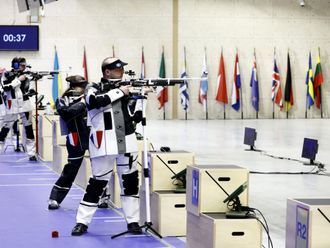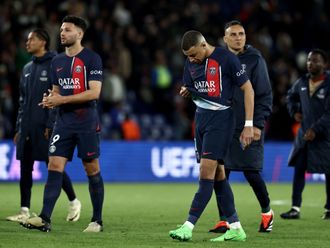
Los Angeles: In a group of more than 100 professional football players whose brains were examined after their death, new research has found that virtually all suffered from chronic traumatic encephalopathy (CTE), a condition likely brought on by repeated blows to the head.
At a Boston University programme that investigates the trauma-linked brain disease, researchers found that, of 111 former players for the National Football League who donated their brains for post-mortem examination, 110 bore the distinctive tangles, plaques and protein clumps now recognised as the neural hallmarks of CTE.
In life, all had suffered at least one of a range of behavioural symptoms — from mood instability and impulsiveness to substance abuse and aggression — that appeared to vary according to an athlete’s age at death, duration of participation in football and level of play. And the loved ones of the majority of the study’s participants told researchers that symptoms of CTE had worsened over the course of the participant’s life.
In nearly 9 out of 10 of those professional athletes — 86 per cent — researchers found the telltale brain abnormalities of CTE were extensive, varied and scattered throughout the brain.
The report, published on Tuesday in the journal Jama, relates the accumulated findings from researchers’ post-mortem examinations of 202 brains, all donated by former football players or their families. Of those, researchers found clear evidence of CTE in 177, or 87.6 per cent, of the brains they examined.
On average, those 177 athletes had played football for 15 years.
From kitchen tables to NFL owners’ boxes, the new report is likely to raise new concerns about the costs to players of a sport that, at its highest levels, has been a showcase for violent hits. As parents have fled the sidelines of youth football, taking their children with them, the NFL has changed rules in a bid to make the game safer, and has acknowledged a link between repeated concussions and players’ impairment. Payouts in a long-running suit by injured players against the NFL were approved last month.
The study’s authors, led by Boston University neuropathologist Ann McKee, cautioned that the study does not suggest severe traumatic brain damage would be found so widely in all who have played football.
“These numbers are very startling and very high, but this is a skewed sample,” McKee told The Times.
In a statement issued on Tuesday, NFL spokesperson Brian McCarthy said “we appreciate the work done by Dr McKee and her colleagues.”
The study leaves “many unanswered questions relating to the cause, incidence and prevalence of long-term effects of head trauma”, he added. But the NFL “is committed to supporting scientific research into CTE and advancing progress in the prevention and treatment of head injuries”, he said, citing the League’s commitment in 2016 to spend $100 million (Dh367.3 million) to support medical research and engineering advancements on brain science.
The 202 brains examined in the study are called a “convenience sample.” They were donated, typically, by families who had witnessed troubling symptoms that often progressed among players. In many cases of suicide, for instance, donor families strongly suspected that trauma-related brain damage had led to their loved one’s death. And most had played football much longer than is typical, often starting young and continuing to play well into their 20s, McKee said.
Suicide was the most common cause of death among those diagnosed in the study with mild CTE, accounting for 27 per cent of those deaths. The most common causes of death among those diagnosed with severe CTE were degenerative diseases such as Alzheimer’s and Parkinson’s disease. Close to half — 47 per cent — of those with signs of severe CTE died of those causes.
In addition, the study did not compare the brains in the convenience sample to the brains of former football players chosen randomly or those who had no neuropsychiatric symptoms.
Not all the study’s participants played football professionally, and the findings of CTE also weren’t limited to NFL players.
Fourteen of the 202 donated brains came from football players who either did not live or did not play past high school, and three of those were found to have CTE.
Fifty-three of the brains analysed in the study were donated by men who had played football at the collegiate level, and CTE was found in 48 of those.
Of 14 participants who had played semi-professional football, nine had CTE. And seven of eight men who had played in the Canadian Football League were found to have the condition.
Neither of two brains that came from donors who had stopped playing football before high school showed signs of CTE.
Half of all the 202 donors whose brains were examined had died before they were 66 and half after their 66th birthday. Researchers concluded that, over the whole sample, the severity of CTE tracked closely with the age at which the subject died, with older donors showing, on average, the clearest and most extensive signs of CTE.
Researchers distinguished between brains with “mild” pathology — 44 of the 177 that showed signs of CTE — and those with “severe” levels of the disease’s structural hallmarks — 133 of the 177 brains examined. On average, those with mild CTE had played football for 13 years. Those found to have severe abnormalities had played football for an average of 15.8 years.
The authors of the study found no clear patterns in players’ positions — offensive and defensive linemen and running backs were most prominently represented in the sample and among those diagnosed with CTE. McKee said some of the patterns researchers did discern ran counter to expectations and will be fodder for important ongoing research.
For instance, many of the men whose families reported the most problematic symptoms, including mood disturbances, explosiveness and self-harm, were found to have only mild levels of CTE’s distinctive brain abnormalities, McKee said.
“We wondered whether there’s another pathology we’re not capturing in the data set,” McKee said — factors that, after trauma, might jump-start brain damage, exacerbate it or simply facilitate its spread across the brain. Possibilities include inflammation, the shearing of the fibres that lash neurons together or damage to the brain’s white matter — the fatty bundles of tissue that carry electrical signals among regions and hemispheres.
“We’ve been looking for eight years but don’t think we’ve captured a way to measure” all the possible factors that make CTE progress, McKee said.
“At some point, there appears to be a progression — at least families complain of progression — and there appears to be a progression after the person has retired from the sport.”
Why, how and how much CTE progresses “remains one of the mysteries of this disease”, McKee said. “We think it’s stimulated by trauma, but how it’s self-perpetuating is unknown.”
Among the other potential contributing factors, age at first exposure to football and cumulative hits, are both under study elsewhere.
McKee said there’s growing evidence that early blows to the head may prove to be especially harmful — a suspicion suggesting that for youth players, a later start for tackle football might be a way to reduce damage. At the very least, she said, it would limit a player’s lifelong exposure to head injuries.
“I believe everyone needs to make their own decisions, given their own personal circumstances,” McKee added. “But I’d definitely encourage athletes to participate in sports that don’t involve head contact, and if they do, to try to adopt manners of play that reduce that impact.”
Limiting contact is an easy approach, McKee said, and taking helmets off for practice is known to change the style of play and reduce blows to the head.
“No head injury is good for you,” McKee said. But for athletes who have been injured, research dictates one absolute, she added: You have to leave the game long enough to recover.
“Injury of an unrecovered brain is very damaging,” she said.












